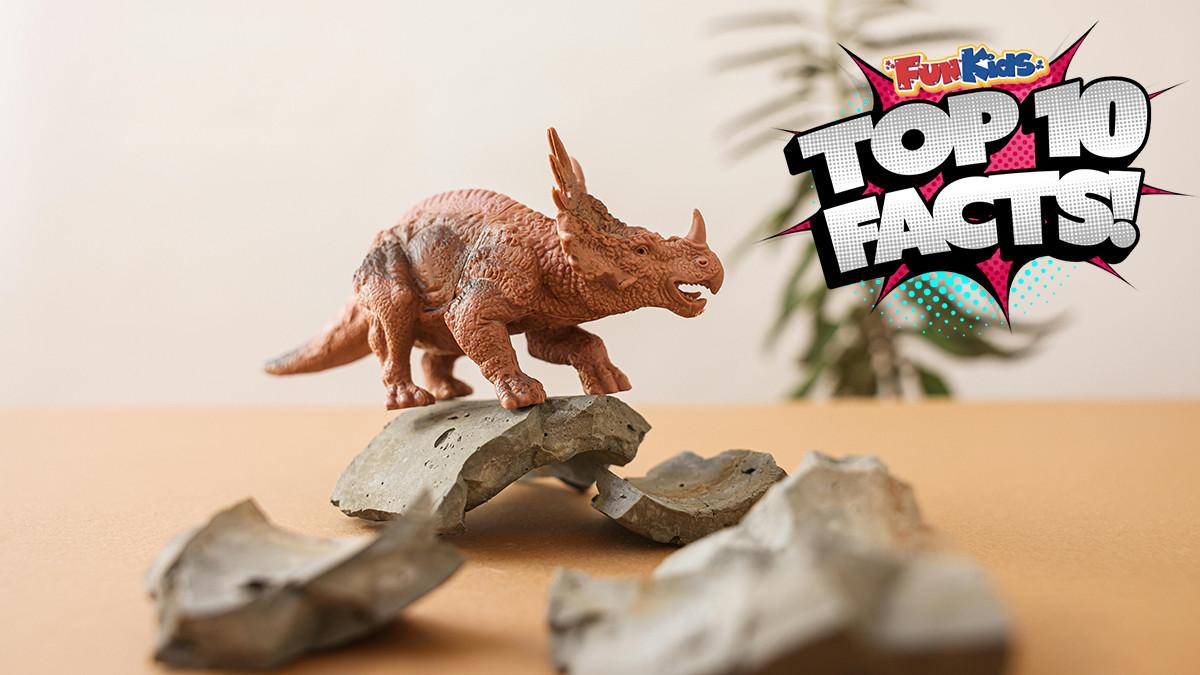Triceratops is one of the most famous and easily recognisable dinosaurs, known for its three horns and large bony frill. This plant-eating giant roamed the Earth during the age of the dinosaurs, and its unique features make it a favourite among dino enthusiasts. Let’s dive into the top 10 fascinating facts about triceratops that make this horned dinosaur so special!
1. Triceratops had three impressive horns.
The name triceratops means ‘three-horned face’, and it certainly lives up to that!
Triceratops had two large horns above its eyes and a smaller one on its nose.
These horns were likely used for defence against predators and possibly for fighting with other triceratops during mating season.
Embed from Getty Images2. Its bony frill was like a shield!
The large frill at the back of triceratops’s head wasn’t just for show – it acted like a shield.
The frill was made of solid bone and helped protect its neck and shoulders from attacks by predators like tyrannosaurus rex.
It may have also been used to show off to other triceratops or as a display to attract mates.
3. Triceratops was a plant-eater (herbivore).
Triceratops was a peaceful herbivore that spent its time munching on plants.
Its beak-like mouth was perfect for clipping tough vegetation, and it had rows of teeth at the back of its mouth for grinding down leaves and twigs.
It likely fed on low-growing plants like ferns, cycads, and palms.
Embed from Getty Images4. It weighed as much as an elephant!
Triceratops was a hefty dinosaur! It weighed around 6 to 12 tonnes, about the same as a large African elephant.
Its bulky body and strong legs helped support its massive weight, and it needed to be this big to fend off predators.
5. Triceratops lived at the end of the dinosaur age.
Triceratops was one of the last dinosaurs to roam the Earth before the mass extinction event that wiped out the dinosaurs.
It lived about 68 to 66 million years ago during the late Cretaceous period, alongside famous predators like tyrannosaurus rex.
Embed from Getty Images6. Its skull was huge and heavy.
Triceratops had one of the largest skulls of any land animal! Its skull could be up to 2.5 metres (8 feet) long, taking up nearly one-third of its body length.
The weight of its skull, including the horns and frill, could be as much as 1 tonne!
That’s like carrying around the weight of a small car on its head.
7. It had hundreds of teeth, but they weren’t for chewing.
Triceratops had between 400 and 800 teeth in its jaws!
However, it didn’t use them for chewing. Instead, these teeth formed a ‘dental battery’ that continuously grew new teeth as old ones wore out.
Triceratops used these teeth to slice through tough plants, swallowing them whole and letting its digestive system do the rest!
8. Its horns may have been used in battles!
Scientists believe that triceratops used its long horns for more than just defence.
Fossil evidence suggests that triceratops may have used its horns to fight with other triceratops, perhaps during battles over territory or mates.
The horns could have locked together in head-to-head combat, much like modern-day animals with antlers or horns.
Embed from Getty Images9. It lived in herds for protection.
Like many other herbivores, triceratops likely lived in groups or herds to protect itself from predators.
Living in a herd would have made it harder for predators like tyrannosaurus rex to single out an individual for attack, and the group’s numbers could offer extra protection.
10. Triceratops fossils are some of the most common dinosaur discoveries.
Triceratops fossils are found more frequently than many other dinosaurs, making it one of the best-known dinosaurs in the fossil record.
Its bones have been discovered across North America, especially in places like Montana, Wyoming, and South Dakota.
Embed from Getty ImagesThanks to these discoveries, scientists have learned a lot about how triceratops lived and behaved.
Triceratops was a magnificent dinosaur, with its iconic horns, giant frill, and powerful body making it one of the most fascinating creatures of the prehistoric world.
Whether it was using its horns for protection or munching on plants, triceratops has left an unforgettable mark on the world of dinosaurs, and it continues to be a favourite among dino-lovers today!
Add a commentTop 10 Facts
From the Tudors to rocks to fish, we have all the best facts right here!
More From Top 10 Facts



